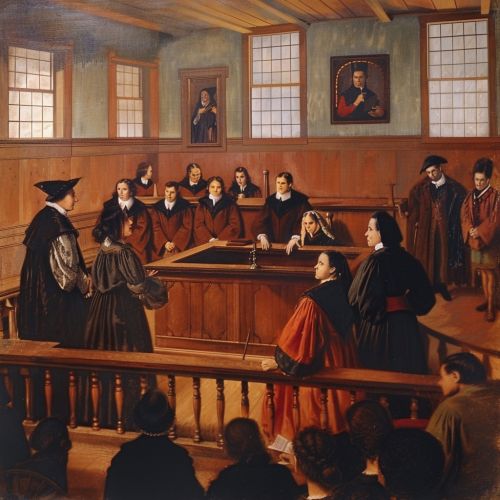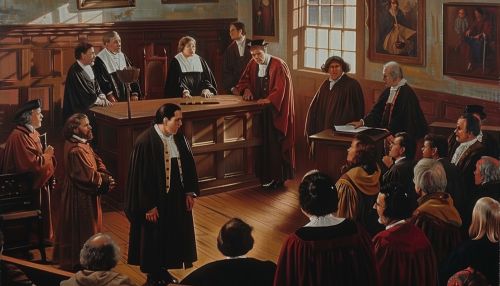The Crucible: Difference between revisions
(Created page with "== Introduction == ''The Crucible'' is a play written by American playwright Arthur Miller in 1953. It is a dramatized and partially fictionalized story of the Salem witch trials that took place in the Massachusetts Bay Colony during 1692–93. Miller wrote the play as an allegory for McCarthyism, when the United States government persecuted people accused of being communists. ''The Crucible'' is regarded as a central work in the canon of American drama. ==...") |
No edit summary |
||
| Line 50: | Line 50: | ||
Judge Danforth is the deputy governor and presiding judge at the witch trials. He is a stern and authoritative figure who is more concerned with maintaining the court's authority than seeking justice. | Judge Danforth is the deputy governor and presiding judge at the witch trials. He is a stern and authoritative figure who is more concerned with maintaining the court's authority than seeking justice. | ||
[[Image:Detail-92555.jpg|thumb|center|Depiction of a courtroom scene during the Salem witch trials, with judges, accused individuals, and spectators.|class=only_on_mobile]] | |||
[[Image:Detail-92556.jpg|thumb|center|Depiction of a courtroom scene during the Salem witch trials, with judges, accused individuals, and spectators.|class=only_on_desktop]] | |||
== Literary Devices == | == Literary Devices == | ||
Latest revision as of 19:03, 17 June 2024
Introduction
The Crucible is a play written by American playwright Arthur Miller in 1953. It is a dramatized and partially fictionalized story of the Salem witch trials that took place in the Massachusetts Bay Colony during 1692–93. Miller wrote the play as an allegory for McCarthyism, when the United States government persecuted people accused of being communists. The Crucible is regarded as a central work in the canon of American drama.
Historical Context
Salem Witch Trials
The Salem witch trials were a series of hearings and prosecutions of people accused of witchcraft in colonial Massachusetts between February 1692 and May 1693. The trials resulted in the executions of twenty people, most of them women, and the imprisonment of many others. The events in Salem were part of a broader pattern of witch hunts in the early modern period, which saw tens of thousands of people executed across Europe and the American colonies.
McCarthyism
McCarthyism refers to the practice of making accusations of subversion or treason without proper regard for evidence. The term is named after U.S. Senator Joseph McCarthy, who led a campaign against alleged communists in the U.S. government and other institutions during the early 1950s. The period is characterized by heightened political repression and a campaign spreading fear of communist influence on American institutions and espionage by Soviet agents.
Plot Summary
The Crucible is set in the Puritan town of Salem, Massachusetts, in 1692. The play opens with Reverend Samuel Parris discovering his daughter Betty, niece Abigail Williams, and other girls dancing in the forest with his slave, Tituba. Betty faints upon being discovered, and rumors of witchcraft spread through the town.
Act I
Reverend Parris is worried about his reputation, while Abigail tries to manipulate the situation to her advantage. The town's residents, including the wealthy and influential Thomas Putnam, begin to accuse others of witchcraft. Reverend John Hale is called to investigate the accusations.
Act II
John Proctor and his wife, Elizabeth, are introduced. Elizabeth urges John to expose Abigail as a fraud, but he is reluctant because of their past affair. Elizabeth is accused of witchcraft, and John vows to save her.
Act III
The court, led by Judge Danforth, is in session. Proctor presents evidence to discredit the accusations, but the court is more interested in preserving its authority than in seeking the truth. Proctor is accused of witchcraft and arrested.
Act IV
Proctor is given the chance to confess and save his life, but he refuses to make a false confession. He is hanged along with other accused witches, and the play ends with the town in disarray.
Themes
Hysteria
The play explores the impact of mass hysteria on a community. The fear of witchcraft leads to irrational behavior and the breakdown of social order. The characters' actions are driven by fear, leading to tragic consequences.
Reputation
Reputation is a central theme in The Crucible. Characters are deeply concerned with their social standing and the opinions of others. Reverend Parris, John Proctor, and Judge Danforth all make decisions based on how they will be perceived by the community.
Integrity
The theme of integrity is explored through the character of John Proctor. Proctor struggles with his sense of guilt and the need to maintain his integrity. His refusal to make a false confession ultimately leads to his death, but he dies with his sense of self intact.
Characters
John Proctor
John Proctor is the play's tragic hero. A local farmer, Proctor is a man of integrity who is flawed by his past affair with Abigail Williams. His internal struggle and ultimate refusal to falsely confess to witchcraft make him a complex and compelling character.
Abigail Williams
Abigail Williams is the play's main antagonist. A manipulative and vengeful young woman, she instigates the witch trials by falsely accusing others of witchcraft. Her motivations are driven by a desire for power and revenge against Elizabeth Proctor.
Reverend John Hale
Reverend Hale is a minister who initially supports the witch trials but becomes disillusioned as he realizes the falsehood and injustice of the accusations. He represents the voice of reason and change in the play.
Elizabeth Proctor
Elizabeth Proctor is John Proctor's wife. She is a moral and upright woman who is accused of witchcraft by Abigail. Her relationship with John is strained by his infidelity, but she ultimately forgives him.
Judge Danforth
Judge Danforth is the deputy governor and presiding judge at the witch trials. He is a stern and authoritative figure who is more concerned with maintaining the court's authority than seeking justice.


Literary Devices
Allegory
The Crucible is an allegory for McCarthyism. Miller uses the Salem witch trials as a metaphor for the anti-communist hysteria of the 1950s. The play critiques the dangers of paranoia, false accusations, and the abuse of power.
Irony
Irony is a prominent literary device in The Crucible. The characters' actions often have unintended and tragic consequences. For example, John Proctor's attempt to expose the truth leads to his own downfall.
Symbolism
The play uses various symbols to convey its themes. The witch trials symbolize the destructive power of hysteria and the loss of rationality. The character of John Proctor symbolizes integrity and moral courage.
Reception and Legacy
The Crucible was initially met with mixed reviews but has since become one of Arthur Miller's most acclaimed works. It is frequently performed and studied in schools and universities. The play's themes of hysteria, reputation, and integrity continue to resonate with contemporary audiences.
Adaptations
The Crucible has been adapted into several films, television productions, and operas. The most notable adaptation is the 1996 film directed by Nicholas Hytner, starring Daniel Day-Lewis as John Proctor and Winona Ryder as Abigail Williams. The play has also been adapted for radio and stage productions worldwide.
See Also
References
- Miller, Arthur. The Crucible. New York: Penguin Books, 1995.
- Hill, Frances. A Delusion of Satan: The Full Story of the Salem Witch Trials. New York: Da Capo Press, 1997.
- Johnson, Paul. A History of the American People. New York: HarperCollins, 1997.
